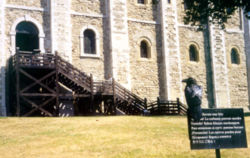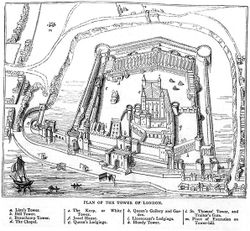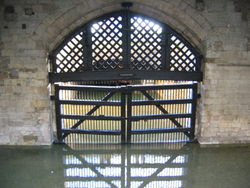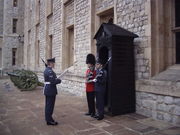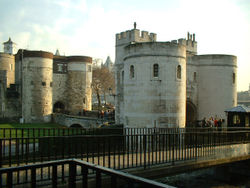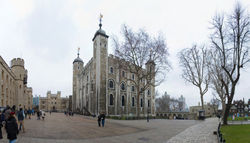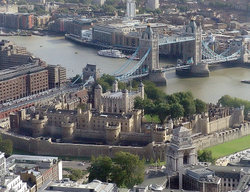Tower of London
2007 Schools Wikipedia Selection. Related subjects: Architecture
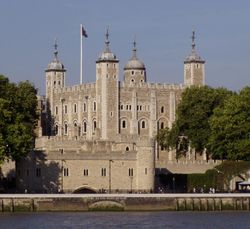
The Tower of London is a dominating landmark in central London—in the London Borough of Tower Hamlets— on the eastern border of the City of London, beside the northern bank of the River Thames.
It is often identified with the White Tower, the original stark, square fortress built by William the Conqueror in 1078. However, the Tower as a whole is a complex of several buildings set within the outer defensive walls and moat.
The Tower's primary function was as a fortress, a royal palace and a prison (particularly for high status and royal prisoners (such as the Princes in the Tower and the future Queen Elizabeth I). This last use has led to the phrase "sent to the Tower" meaning "imprisoned". It has also served as a place of execution and torture, an armoury, a treasury, a zoo, a mint, a public records office, and an observatory.
History
The Tower of London was founded in 1078 when William the Conqueror ordered the White Tower to be built inside the SE angle of the City walls, adjacent to the Thames . This was as much to protect the Normans from the people of the City of London as to protect London from outside invaders. William ordered the Tower to be built of stone which he had specially imported from France and appointed Gundulf, Bishop of Rochester as the architect.
Some writers, such as Shakespeare, in his play Richard III, have ascribed an earlier origin to the Tower of London and have stated that it was built by Julius Caesar. This supposed Roman origin is, however a myth, as is the story that the mortar used in its construction was tempered by the blood of beasts.
In the 12th century King Richard the Lionheart enclosed the White Tower with a curtain wall and had a moat dug around it filled with water from the Thames. The moat was not very successful until Henry III, in the 13th century, employed a Dutch moat building technique. This king greatly strengthened the curtain wall, breaking down the city wall to the east, to extend the circuit, despite the remonstances of the citizens of London and even supernatural warnings—if the contemporary monastic chronicler Matthew Paris is to be believed. Henry III transformed the Tower into a major royal residence and had palatial buidings constructed within the Inner Bailey.
The fortification was completed by between 1275 and 1285 by Edward I who built the outer curtain wall, completely enclosing the inner wall and thus creating a concentric double defence. He filled in the pre-existing moat and built a new moat around the new outer wall.
The Tower remained a royal residence until the time of Oliver Cromwell who demolished the old palatial buidings.
Menagerie
A Royal Menagerie was established at the Tower in the 13th century, possibly as early as 1204 during the reign of King John, and probably stocked with animals from an earlier menagerie started in 1125 by Henry I at his palace in Woodstock, near Oxford. Its year of origin is often stated as 1235, when Henry III received a wedding gift of three leopards (so recorded, although they may have been lions) from Frederick II, Holy Roman Emperor. In 1264 they were moved to the Bulwark, which was duly renamed the Lion Tower, near the main western entrance. It was opened as an occasional public spectacle in the reign of Elizabeth I. A lion skull was radiocarbon dated to between 1280 and 1385, making it the earliest medieval big cat known in Britain.
By 1804, the menagerie was regularly open to the public. This was where William Blake saw the tiger which may have inspired his poem The Tyger. The menagerie's last director, Alfred Cops, who took over in 1822, found the collection in a dismal state, but restocked it and issued an illustrated scientific catalogue. The menagerie was not to last because the new London Zoo was due to open in Regent's Park. Partly for commercial reasons and partly for animal welfare, the animals were moved to the zoo. The last of the animals left in 1835, and most of the Lion Tower was demolished soon after, although Lion Gate remains.
Ravens
There have been at least six (there are currently eight) ravens in residence at the Tower for centuries, although the exact point in history when they arrived is unknown. Charles II ordered their removal when he discovered their droppings all over his telescope. However, they were not removed because Charles was then told of the legend that if the ravens ever leave the Tower of London, the White Tower, the Monarchy, and the entire Kingdom would fall. And Charles, during the time of the English Civil War, superstition or not, was not prepared to take the chance. The only recorded occurrence of the ravens being absent at the tower was in the year 1946.
The ravens' wings are now clipped to prevent them from flying away, and they are cared for by the Ravenmaster, a duty given to one of the Yeomen Warders.
The ravens' names are (as of August 2005):
- Gwylum (M) aged 17 yrs
- Thor (M) 14 yrs
- Hugine (F) 10 yrs
- Munin (F) 10 yrs
- Branwen (F) 3 yrs old
- Bran (M) 2 yrs
- Gundulf (M) 5 months
- Baldrick (M) 5 months
The oldest raven ever to serve at the Tower of London was called Jim Crow, who died at the age of 44.
In 2006, ahead of the H5N1 avian flu scare, the ravens were moved indoors; as of July 2006, they are once again free to roam about the grounds within the Tower complex.
Prisoners in the Tower
The Tower of London was used as a prison for those of high rank and for religious dissidents. Those of high rank, including prisoners of royal status, were housed in relative comfort. Religious dissidents were however much more severely treated and were often tortured.
The first prisoner was Ranulf Flambard in 1100 who, as Bishop of Durham, was found guilty of extortion. Ironically he had himself been responsible for various improvements to the design of the Tower after the first architect Gundulf moved back to Rochester. He escaped from the White Tower by shinning down a rope, which had been smuggled into his cell in a wine casket.
Other prisoners include:
- John Baliol King of Scotland
- David II King of Scotland
- John II King of France
- Henry VI of England was imprisoned in the Tower, where he was murdered on the 21 of May 1471. Popular legend has accused Richard, Duke of Gloucester of his murder. Each year on the anniversary of Henry VI's death, the Provosts of Eton and King's College, Cambridge, lay roses and lilies on the altar which now stands where he died.
- Margaret of Anjou, wife of the above
- Sir William de la Pole. A distant relative of the King, he was incarcerated at the Tower for 37 years (1502-1539) for allegedly plotting against Henry VII thus becoming the longest serving prisoner here.
- Sir Walter Ralegh spent thirteen years imprisoned at the Tower but was able to live in relative comfort in the Bloody Tower with his wife and two children. For some of the time he even grew tobacco on Tower Green, just outside his apartment. Here he wrote The History of the World.
- Niall Garve O'Donnell Irish nobleman, ironicaly a one-time ally of the English against his cousin, Red Hugh O'Donnell.
- Guy Fawkes, famous for his part in the Gunpowder Plot, was brought to the Tower to be interrogated by a council of the King's Ministers. However, he was not executed here. When he confessed he was hung, drawn and quartered in the Old Palace Yard at Westminster.
- Johan Anders Jägerhorn, a Swedish officer from Finland, Lord Edward FitzGeralds friend, participating in the Irish independence movement. Spent two years in the Tower 1799-1801, but was released because of Russian interests.
Executions and torture
Lower-class criminals were usually executed by hanging at one of the public execution sites outside the Tower. Several high-profile convicts, such as Thomas More, were publicly executed on Tower Hill. Seven nobles (five of them ladies) were beheaded privately on Tower Green, inside the complex, and then buried in the " Chapel Royal of St. Peter ad Vincula" (Latin for "in chains," making him an appropriate patron saint for prisoners) next to the Green. Some of the nobles who were executed outside the Tower are also buried in that chapel. ( External link to Chapel webpage) The names of the seven beheaded on Tower Green for treason are:
- William Hastings, 1st Baron Hastings ( 1483)
- Anne Boleyn ( 1536)
- Margaret Pole, Countess of Salisbury ( 1541)
- Catherine Howard ( 1542)
- Jane Boleyn, Viscountess Rochford ( 1542)
- Lady Jane Grey ( 1554)
- Robert Devereux, 2nd Earl of Essex ( 1601)
The Queen Anne Boleyn, beheaded in 1536 for treason against King Henry VIII, is said to be occasionally seen walking around the tower carrying her head under her arm.
George, Duke of Clarence, the brother of Edward IV of England, was executed for treason in the Tower in February 1478, but not by beheading (and probably not by being drowned in a butt of Malmsey wine, despite what Shakespeare wrote). When Edward IV died, he left two young sons behind: the Princes in the Tower. His brother Richard, the Duke of Gloucester, was made regent until the older of his two sons, Edward V, should come of age. According to Thomas More's History of Richard III Richard hired men to kill them, and, one night, the two princes were smothered with their pillows. Many years later bones were found buried at the foot of a stairway in the Tower, which were identified as those of the Princes. Richard was crowned King Richard III of England.
Anne Askew is the only woman on record to have been tortured in the tower after being taken there in 1546 on a charge of heresy. Sir Anthony Kingston, the Constable of the Tower of London, was ordered to torture Anne in an attempt to force her to name other Protestants. Anne was put on the Rack. Kingston was so impressed with the way Anne behaved that he refused to carry on torturing her, and Henry VIII's Lord Chancellor had to take over.
Recent history
The military use of the Tower as a fortification, like that of other such castles, became obsolete with the introduction of artillery and the moat was drained in 1830. However the Tower did serve as the headquarters of the Board of Ordnance until 1855, and the Tower was still occasionally used as a prison, even through both World Wars. In 1780, the Tower held its only American prisoner, former President of the Continental Congress, Henry Laurens. In World War I, eleven German spies were shot in the Tower. Irish rebel Roger Casement was imprisoned in the Tower during his trial on treason charges in 1916. A German spy had the distinction of being the last person to be executed in the Tower. He was shot on August 15, 1941 during World War II.
In the following year, Hitler's deputy, Rudolf Hess, was imprisoned in the tower for four days. During this time, RAF Wing Commander George Salaman was placed in the same cell undercover, impersonating a Luftwaffe officer, to spy on Hess. Although acting in a covert manner and not held as a true inmate, Salaman remains the last Englishman to be locked in the Tower of London.
Waterloo Barracks, the current location of the Crown Jewels, remained in use as a base for the 1st Battalion Royal Fusiliers (City of London Regiment) into the 1950s; during 1952 the Kray twins were briefly held there for failing to report for national service, making them among the last prisoners of the Tower; the last British citizen held for any length of time was the traitorous Army officer Norman Baillie-Stewart from 1933 to 1937.
Although it is no longer occupied by the Royal Family, the Tower officially remains a royal residence, and as such, maintains a permanent Guard—this is found by the unit forming the Queen's Guard at Buckingham Palace. Two sentries are maintained during the hours that the Tower is open, with one stationed outside the Jewel House and one outside the Queen's House.
In 1974, there was a bomb explosion in the mortar room in the White tower leaving one person dead and 41 injured. No one claimed responsibility for the blast, however the police were investigating suspicions that the IRA was behind it.
Administration
The Tower of London and its surrounding area has always had a separate administration from the adjacent City of London. It was, anciently, under the jurisdiction of Constable of the Tower who also held authority over the Tower liberties until 1894. In addition the Constable was ex-officio Lord Lieutenant of the Tower division of Middlesex until 1889, and head of the Tower Hamlets Militia until 1871.
Description

The Tower can be described as a " palimpsest". The oldest visible structure is the White Tower (which is 11th century); other elements added over the centuries are evident, right up to modern additions, most of which cater for the tourist or security needs.
The Tower today is principally a tourist attraction. Besides the buildings themselves, the British Crown Jewels, a fine armour collection from the Royal Armouries, and a remnant of the wall of the Roman fortress are on display.
The tower is manned by the Yeomen Warders (known as Beefeaters), who act as tour guides, provide discreet security, and are something of a tourist attraction in their own right. Every evening, the warders participate in the Ceremony of the Keys, as the Tower is secured for the night.
The Tower includes the following towers, listed in alphabetic order:
- Beauchamp Tower
- Bell Tower
- Bloody Tower (or the Garden Tower)
- Bowyer Tower
- Brick Tower
- Broad Arrow Tower
- Byward Tower
- Constable Tower
- Cradle Tower
- Develin Tower
- Deveraux Tower
- Flint Tower
- Lanthorn Tower
- Martin Tower
- Middle Tower
- St. Thomas's Tower
- Salt Tower
- Wakefield Tower
- Wardrobe Tower
- Well Tower
- White Tower
Crown Jewels
The Crown Jewels have been kept at the Tower of London since 1303 after they were stolen from Westminster Abbey. It is thought that most, if not all, were recovered shortly afterwards. After the coronation of Charles II, they were locked away and shown for a viewing fee paid to a custodian. However, this arrangement ended when Colonel Thomas Blood stole the Crown Jewels after having bound and gagged the custodian. Thereafter, the Crown Jewels were kept in a part of the Tower known as Jewel House, where armed guards defend them. They were temporarily taken out of the Tower during World War II, and reportedly were secretly kept in the basement vaults of the Sun Life Insurance company in Montreal, Canada, along with the gold bullion of the Bank of England. However, it has also been said that they were kept in the Round Tower of Windsor Castle, or the Fort Knox Bullion Depository in the United States.
Location
The Tower is located at the eastern boundary of the City of London financial district, adjacent to the River Thames and Tower Bridge. Between the river and the Tower is Tower Wharf, a freely accessible walkway with excellent views of the river, tower and bridge, together with HMS Belfast and London City Hall on the opposite bank.
The nearest public transport locations are:
- Tower Hill tube station (London Underground District and Circle lines)
- Tower Gateway DLR station ( Docklands Light Railway)
- Fenchurch Street railway station ( National Rail)
- Tower Millennium Pier (river cruise boats)
- St Katherine's Dock ( Thames Clipper commuter boats)
In fiction
- The Tower of London, as a place of death, darkness and treachery, is most famously evoked in William Shakespeare's play, Richard III, where it forms the backdrop of a tyrant's rise to power and the scene of the notorious murder of the Princes in the Tower, amongst other victims (see above).
- This horror is reprised in the novel The Tower of London (1840) by William Harrison Ainsworth. Though written in fictional form, Ainsworth's tale contrives to give a detailed account of the history and architecture of the Tower.
- The Tower is the setting for Gilbert and Sullivan's 1888 light opera The Yeomen of the Guard.

